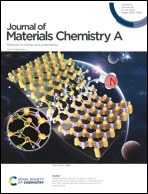Supercritical CO2-constructed intralayer [Bi2O2]2+ structural distortion for enhanced CO2 electroreduction†
Abstract
Inducing crystal distortion in two-dimensional (2D) materials to increase the number of active sites is of great significance in improving the intrinsic activity of electrocatalysts for the CO2 reduction reaction (CO2RR). Developing 2D materials as thin as possible is required for this goal. Herein, taking layered BiOCl as a prototype model, we achieved the intralayer [Bi2O2]2+ structural distortion by using supercritical CO2 as a solvent to reduce the number of interlayer chlorine atoms involved in the reaction. Contrary to expectations, further CO2RR experiments indicate that thick nanoplates exhibit a high faradaic efficiency of ∼92% for conversion of CO2 to formate in a wide potential window, whereas ultrathin nanosheets mainly produce H2. Density functional theory calculation shows that increased [Bi2O2]2+ structural distortion in thick nanoplate layers is responsible for the finding. This strategy provides a new route to promoting the intrinsic activity of electrocatalysts, and provides us with a new insight into understanding thickness-dependent activity.
![Graphical abstract: Supercritical CO2-constructed intralayer [Bi2O2]2+ structural distortion for enhanced CO2 electroreduction](/en/Image/Get?imageInfo.ImageType=GA&imageInfo.ImageIdentifier.ManuscriptID=D0TA04163G&imageInfo.ImageIdentifier.Year=2020)


 Please wait while we load your content...
Please wait while we load your content...